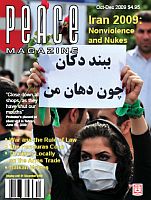
Peace Magazine Oct-Dec 2009, page 28. Some rights reserved.
Search for other articles by Walter Dorn here
Lieutenant-Colonel John Conrad, Dundurn Press and the Canadian Defence Academy, Toronto and Kingston, 2009.
This book provides an engaging and informative first-hand view of Canadian operations in Kandahar, based on the author's tour there in 2006. The book is filled with keen insights covering the tactical and operational levels, occasionally touching on the strategic. The human face of the Canadian Forces (CF) is clearly presented; a face that can smile, yell, demand and at times cry. The author has showed the strong bonding that develops between soldiers sent to the field, especially during combat periods. The tragedy of death and dying is strongly present throughout, something important to show in brutal frankness. General Sherman's "war is hell" rings true once again. But, as the author also demonstrates so well, war also brings forth courage, daring and commitment far beyond the call of duty. The author's life experience in Afghanistan is a testament to that.
The book makes a strong and convincing case for the under-appreciated but vital and danger-filled role played by the CF logistics personnel in Kandahar, which operated under the name of the National Support Element (NSE). Lt-Col. Conrad was the commander of this 300-strong unit. His complaints that logistics is neglected or worse in the CF is repeated many times, almost to the point of annoyance. At times, the case may have been overstated with words like the "cultural disdain" for logistics, but this is a symbol of widespread frustration in the support services over a well-founded problem of "fighting-echelon elitism" in the Canadian Forces. Given that a major theme of the book is the undervalued work of the NSE, an even more accurate subtitle for the book would be "Reflections of a Canadian Logistics Officer in Kandahar." But if his point were accurate, that might sell fewer copies.
A minor frustration is that some stories are left unfinished. Having been strongly drawn into the narrative, the reader would naturally like to know what happened at the end of several incidents but is left hanging. For example, from the Preface of the book, when US Colonel Kevin Owens put Canadian Brigadier-General General David Fraser on the spot by asking him about logistics on 30 October 2005, how did the Canadian respond? I was so curious about how that incident turned out that I kept thinking through the rest of book that the answer might come at the conclusion of the book. No such luck!
The book contains many creative and brilliant turns of phrase and rich analogies. For example, consider the following descriptions: US Col Owens led Regional Command (RC) South "with a surgeon's scalpel the way Theodore Roosevelt had carried a big stick" (p.18); the "enemy is everywhere and nowhere in particular" in southern Afghanistan (p.20). Also the book provides some timeless insights: the insurgents "like young people the world over, seemed intoxicated with the romance of their struggle" (p.204). The title itself is excellent, with a good explanation of "the Thunder" at the beginning of the book and a wonderful return to it in the last line of the work.
The weakest part of the book, in this reviewer's view, is the simplistic treatment of the justice of the cause for fighting ("Why Have We Come?" Chapter 5). While there is some truth to the short-term view that fighting the Taliban over there is making it "harder for terrorists to strike Canada" (p.71), it is a decidedly narrow view. It does not take into account, the great vulnerability we humans have to violence from others from around the globe or at home, nor the fact that US, Canadian and NATO actions have been enraging people around the world, including Toronto (even giving rise to would-be Canadian-born terrorists). The view does not take into account the globalization of travel, information and the ease of response. Should someone (e.g., from Afghanistan or Pakistan) be sufficiently enraged to seek to kill people in Canada they could do it in the years to come. Fortunately, a restrained and restraining Muslim world has not harbored elements that have carried this out in North America. Most importantly, the view does not recognize that it was not the Taliban which designed and carried out 9/11. By widening the war to the Taliban and regime change, US president George Bush overstepped the bounds of justifiability. His September 11 statement that "we will make no distinction between the terrorists and those who harbor them" was not only a violation of the principle of combatant distinction in international law. It was also a recipe for an ever-widening war, which we now see in Pakistan. However repugnant the methods and religio-cultural practices of the Taliban, they have a case to make that they are acting in self-defence and for their local national pride, as their forefathers had resisted previous "invaders."
If the West does not recognize that there is even an iota of humanity or rationality in these people's actions, then it won't solve the problem. The simplistic label of "terrorist" will come back to haunt us. This is an important lesson for the post-Bush era.
While no one should deny the Canadian solider his or her right to believe in the cause, a more sophisticated treatment of the subject of just cause would have helped, at least to counter or acknowledge some of the arguments mentioned above.
It takes great talent and dedication to write up these adventures. Lt. Col Conrad has shown himself to be a very insightful writer and a superb story-teller. We owe him a debt of gratitude for allowing us to share in his Afghan experience.
Reviewed by Walter Dorn, who teaches military officers and civilian students at the Canadian Forces College in Toronto.

Peace Magazine Oct-Dec 2009, page 28. Some rights reserved.
Search for other articles by Walter Dorn here